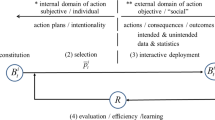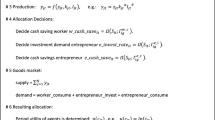Abstract
We consider a stationary, infinite horizon aggregative model with one consumer and one producer living in each period. A decentralized intertemporal mechanism, satisfying the following “evolutionary” property, is constructed: if the current period's producer and consumer verify their equilibrium conditions, then the allocation is actually executed, without further verification by future agents. The mechanism is based on the idea of continual planning revision. It is shown that the outcome is an intertemporally efficient allocation which maximizes the long run average of one period utilities from consumption.
Similar content being viewed by others
References
Arrow, K. J., and Hahn, F. (1971):General Competitive Analysis. San Francisco: Holden-Day.
Atsumi, H. (1965): “Neoclassical Growth and Efficient Program of Capital Accumulation.”Review of Economic Studies 32: 127–136.
Bhattacharya, R. N., and Majumdar, M. (1989): “Controlled Semi-Markov Models under Long-Run Average Rewards.”Journal of Statistical Planing and Inference 22: 223–242.
Birkhoff, G., and MacLane, S. (1977):A Survey of Modern Algebra. New York: Macmillan.
Blackwell, D. (1962): “Discrete Dynamic Programming.”Annals of Mathematical Statistics 33: 719–726.
Brock, W. A. (1971): “Sensitivity of Optimal Growth Paths with Respect to a Change in Target Stocks.” InContributions to the Von Neumann Growth Model, edited by G. Bruckmann and W. Weber. New York: Springer.
Brock, W. A., and Majumdar, M. (1988): “On Characterizing Optimal Competitive Programs in Terms of Decentralizable Conditions.”Journal of Economic Theory 45: 262–273.
Cass, D. (1972): “On Capital Overaccumulation in the Aggregative Neo-Classical Model of Economic Growth: A Complete Characterization.”Journal of Economic Theory 4: 200–223.
Dasgupta, A. (1964): “A Note on Optimum Savings.”Econometrica 32: 431–433.
Dasgupta, S., and Mitra, T. (1988a): “Characterization of Intertemporal Optimality in Terms of Decentralizable Conditions: The Discounted Case.”Journal of Economic Theory 45: 247–287.
—, (1988b): “Intertemporal Optimality in a Closed Linear Model of Production.”Journal of Economic Theory 45: 288–315.
Dutta, P. K. (1986): “Essays in Intertemporal Allocation Theory.” Ph. D. Thesis, Cornell University, Ithaca, New York.
Dutta, P. K. (1989): “What Do Discounted Optima Converge to? A Theory of Discount Rate Asymptotics in economic Models.” Discussion Paper No. 426, Columbia University.
Flynn, J. (1976): “Conditions for the Equivalence of Optimality Criteria in Dynamic Programming.”Annals of Mathematical Statistics 4: 936–953.
Gale, D. (1967): “On Optimal Development in a Multi-Sector Economy.”Review of Economic Studies 34: 1–18.
Gale, D., and Sutherland, W. R. S. (1968): “Analysis of a One-Good Model of Economic Development.” InMathematics of the Decision Sciences, Part 2, edited by G. B. Dantzig and A. F. Veinott, Jr. (Lectures in Applied Mathematics 12). Providence: American Mathematical Society.
Goldman, S. M. (1968): “Optimal Growth and Continual Planning Revision.”Review of Economic Studies 35: 145–154.
Hahn, F. (1989): “Auctioneer.” InThe New Palgrave: General Equilbrium, edited by J. Eatwell, M. Milgate and P. Newman. London: Macmillan.
Howard, R. (1960):Dynamic Programming and Markov Processes. Cambridge, Mass: MIT Press.
Hurwicz, L. (1986): “On Intertemporal Decentralization and Efficiency in Resource Allocation Mechanisms.”Studies in Mathematics 25: 238–350.
Hurwicz, L., and Majumdar, M. (1988): “Optimal Intertemporal Allocation Mechanisms and Decentralization of Decisions.”Journal of Economic Theory 45: 228–261.
Hurwicz, L., and Weinberger, H. (1990): “A Necessary Condition for Decentralization and an Application to Intertemporal Allocation.”Journal of Economic Theory 51: 313–345.
Jeanjean, P. (1974): “Optimal Development Programs under Uncertainty: The Undiscounted Case.”Journal of Economic Theory 7: 66–92.
Koopmans, T. C. (1957):Three Essays on the State of Economic Science. New York: McGraw Hill.
Majumdar, M. (1988): “Decentralization in Infinite Horizon Economies: An Introduction.”Journal of Economic Theory 45: 217–227.
Malinvaud, E. (1953): “Capital Accumulation and Efficient Allocation of Resources.”Econometrica 21: 233–268.
Mount, K., and Reiter, S. (1974): “The Informational Size of Message Spaces.”Journal of Economic Theory 8: 161–192.
Pigou, A. C. (1928):The Economics of Welfare. London: Macmillan.
Ramsey, F. (1928): “A Mathematical Theory of Savings.”Economic Journal 38: 543–559.
Rawls, J. (1971):A Theory of Justice. Cambridge, Mass.: Belknap Harvard.
Ross, S. (1968): “Arbitrary State Markovian Decision Processes.”Annals of Mathematical Statistics 39: 2118–2122.
Samuelson, P. A. (1958): “An Exact Consumption-Loan Model of Interest With or Without the Social Contrivance of Money.”Journal of Political Economy 66: 467–482.
Scarf, H. (1960): “Some Examples of Global Instability of the Competitive Equilibrium.”International Economic Review 1: 157–172.
Smale, S. (1989): “Global Analysis in Economic Theory.” InThe New Palgrave: General Equilibrium, edited by J. Eatwell, M. Milgate and P. Newman. London: Macmillan.
Veinott Jr., A. F. (1966): “On Finding Optimal Policies in Discrete Dynamic Programming with no Discounting.”Annals of Mathematical Statistics 37: 1284–1294.
Weizsäcker, C. C. von (1965): “Existence of Optimal Programs of Accumulation for an Infinite Time Horizon.”Review of Economic Studies 32: 85–104.
Author information
Authors and Affiliations
Additional information
We would like to thank L. Hurwicz, E. Malinvaud, and R. Radner for valuable discussions, and two referees for helpful comments. Research on this project was partially supported by a National Science Foundation Grant.
Rights and permissions
About this article
Cite this article
Bala, V., Majumdar, M. & Mitra, T. Decentralized evolutionary mechanisms for intertemporal economies: A possibility result. Zeitschr. f. Nationalökonomie 53, 1–29 (1991). https://doi.org/10.1007/BF01227013
Received:
Revised:
Issue Date:
DOI: https://doi.org/10.1007/BF01227013




